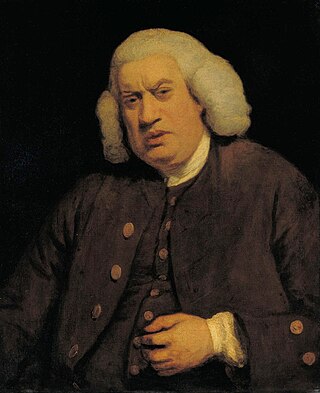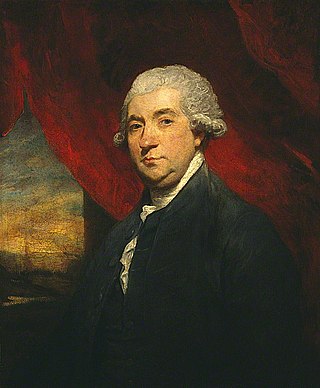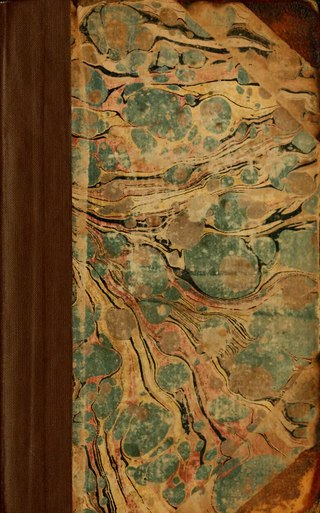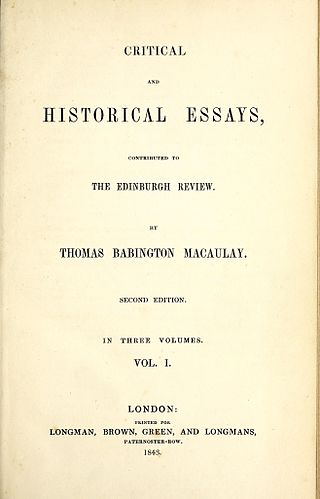19th-century criticism
Macaulay's critique in the Edinburgh Review [20] was highly influential and established a way of thinking of Boswell and his Life of Johnson which was to prevail for many years. Macaulay was damning of Croker's editing: "This edition is ill compiled, ill arranged, ill written, and ill printed". [20] And the famously ambivalent opinion Macaulay gave of Boswell himself was that the unquestioned excellence of the Life was possible only because of traits and habits of Boswell's that Macaulay saw as contemptible: "Servile and impertinent, shallow and pedantic, a bigot and a sot, bloated with family pride, and eternally blustering about the dignity of a born gentleman, yet stooping to be a talebearer, an eavesdropper, a common butt in the taverns of London[;] ... such was this man, and such he was content and proud to be". [20] Macaulay also claimed "Boswell is the first of biographers. He has no second. He has distanced all his competitors so decidedly that it is not worth while to place them". [20] Macaulay also criticised (as did Lockhart) what he saw as a lack of discretion in the way the Life reveals Johnson's and others' personal lives, foibles, habits and private conversation; but contended that it was this that made the Life of Johnson a great biography.
Without all the qualities which made him the jest and the torment of those among whom he lived, without the officiousness, the inquisitiveness, the effrontery, the toad-eating, the insensitivity to all reproof, he could never have produced so excellent a book. He was a slave, proud of his servitude, a Paul Pry, convinced that his own curiosity and garrulity were virtues, an unsafe companion who never scrupled to repay the most liberal hospitality by the basest violation of confidence, a man without delicacy, without shame, without sense enough to know when he was hurting the feelings of others or when he was exposing himself to derision; and because he was all this, he has, in an important department of literature, immeasurably surpassed such writers as Tacitus, Clarendon, Alfieri, and his own idol Johnson. [20]
Macaulay noted that Boswell could give a detailed account only of Johnson's later years: "We know him [Johnson], not as he was known to men of his own generation, but as he was known to men whose father he might have been" [20] and that long after Johnson's own works had been forgotten, he would be remembered through Boswell's Life:
... that strange figure which is as familiar to us as the figures of those among whom we have been brought up, the gigantic body, the huge massy face, seamed with the scars of disease, the brown coat, the black worsted stockings, the grey wig with the scorched foretop, the dirty hands, the nails bitten and pared to the quick. We see the eyes and mouth moving with convulsive twitches; we see the heavy form rolling; we hear it puffing; and then comes the "Why sir!" and "What then, sir?" and the "No, sir!" and the "You don't see your way through the question, sir!" What a singular destiny has been that of this remarkable man! To be regarded in his own age as a classic, and in ours as a companion. To receive from his contemporaries that full homage which men of genius have in general received only from posterity! To be more intimately known to posterity than other men are known to their contemporaries! That kind of fame which is commonly the most transient is, in his case, the most durable. The reputation of those writings, which he probably expected to be immortal, is every day fading; while those peculiarities of manner and that careless table-talk the memory of which, he probably thought, would die with him, are likely to be remembered as long as the English language is spoken in any quarter of the globe ..." [20]
Thomas Carlyle wrote two essays in Fraser's Magazine in 1832 in review of Croker's edition. The first of Carlyle's two essays, on 'Biography', appeared in issue 27, [21] with the second, 'Boswell's Life of Johnson', in issue 28. [22] Carlyle wanted more than facts from histories and biographies: "The thing I want to see is not Redbook Lists and Court Calendars, and Parliamentary Registers, but the LIFE OF MAN in England: what men did, thought, suffered, enjoyed; the form, especially the spirit, of their terrestrial existence, its outward environment, its inward principle; how and what it was; whence it proceeded, whither it was tending." [22] Carlyle professed to find this in the Life, even in its simplest anecdotes: "Some slight, perhaps mean and even ugly incident if real and well presented, will fix itself in a susceptive memory and lie ennobled there [21] ". Consequently, "This Book of Boswell’s will give us more real insight into the History of England during those days that twenty other Books, falsely entitled “Histories” which take to themselves that special aim". [22] "How comes it," Carlyle asked, "that in England we have simply one good Biography, this Boswell’s Johnson?" [21] Carlyle shared Macaulay's unfavourable verdict on Croker's editorial efforts: "there is simply no edition of Boswell to which this last would seem preferable". [22] Carlyle did not, however, share Macaulay's view of Boswell's character. Boswell, though "a foolish, inflated creature, swimming in an element of self-conceit" [22] ), had had, said Carlyle, the great good sense to admire and attach himself to Dr Johnson (an attachment which had little to offer materially) and the open loving heart which Carlyle thought indispensable for knowing and vividly uttering forth [21] :
Boswell wrote a good Book because he had a heart and an eye to discern Wisdom, and an utterance to render it forth; because of his free insight, his lively talent, above all, of his Love and childlike Open-mindedness. His sneaking sycophancies, his greediness and forwardness, whatever was bestial and earthy in him, are so many blemishes in his Book, which still disturb us in its clearness; wholly hindrances, not helps. Towards Johnson, however, his feeling was not Sycophancy, which is the lowest, but Reverence, which is the highest of human feelings. [22] That loose-flowing, careless-looking Work of his is as a picture by one of Nature's own Artists; the best possible resemblance of a Reality; like the very image thereof in a clear mirror. Which indeed it was: let but the mirror be clear, this is the great point; the picture must and will be genuine. How the babbling Bozzy, inspired only by love, and the recognition and vision which love can lend, epitomises nightly the words of Wisdom, the deeds and aspects of Wisdom, and so, by little and little, unconsciously works together for us a whole Johnsoniad; a more free, perfect, sunlit and spirit-speaking likeness than for many centuries had been drawn by man of man! [22]















